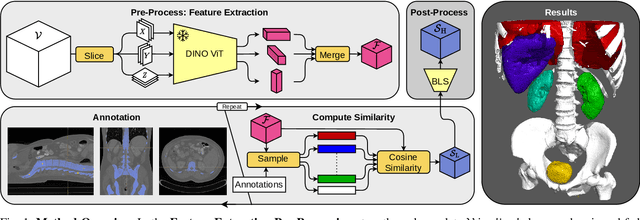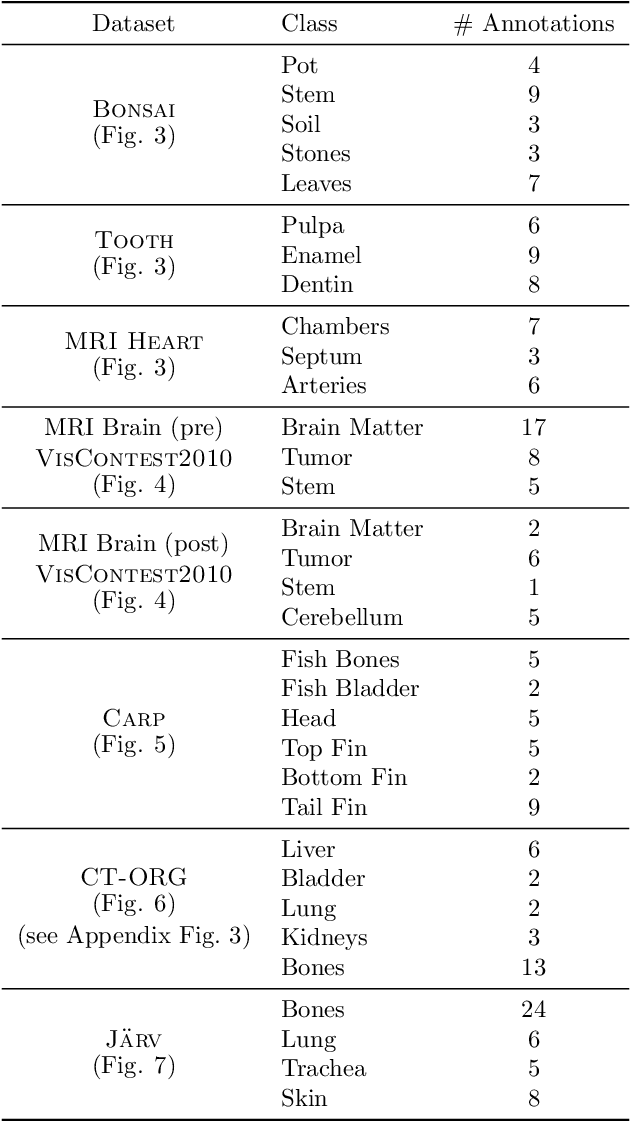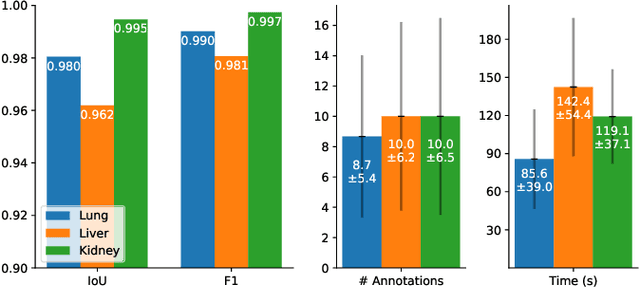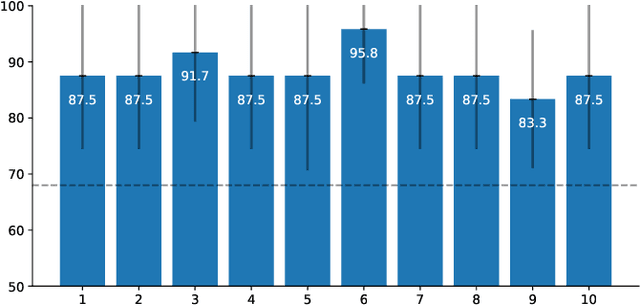Leon Sick
Masked Scene Modeling: Narrowing the Gap Between Supervised and Self-Supervised Learning in 3D Scene Understanding
Apr 09, 2025Abstract:Self-supervised learning has transformed 2D computer vision by enabling models trained on large, unannotated datasets to provide versatile off-the-shelf features that perform similarly to models trained with labels. However, in 3D scene understanding, self-supervised methods are typically only used as a weight initialization step for task-specific fine-tuning, limiting their utility for general-purpose feature extraction. This paper addresses this shortcoming by proposing a robust evaluation protocol specifically designed to assess the quality of self-supervised features for 3D scene understanding. Our protocol uses multi-resolution feature sampling of hierarchical models to create rich point-level representations that capture the semantic capabilities of the model and, hence, are suitable for evaluation with linear probing and nearest-neighbor methods. Furthermore, we introduce the first self-supervised model that performs similarly to supervised models when only off-the-shelf features are used in a linear probing setup. In particular, our model is trained natively in 3D with a novel self-supervised approach based on a Masked Scene Modeling objective, which reconstructs deep features of masked patches in a bottom-up manner and is specifically tailored to hierarchical 3D models. Our experiments not only demonstrate that our method achieves competitive performance to supervised models, but also surpasses existing self-supervised approaches by a large margin. The model and training code can be found at our Github repository (https://github.com/phermosilla/msm).
CutS3D: Cutting Semantics in 3D for 2D Unsupervised Instance Segmentation
Nov 26, 2024Abstract:Traditionally, algorithms that learn to segment object instances in 2D images have heavily relied on large amounts of human-annotated data. Only recently, novel approaches have emerged tackling this problem in an unsupervised fashion. Generally, these approaches first generate pseudo-masks and then train a class-agnostic detector. While such methods deliver the current state of the art, they often fail to correctly separate instances overlapping in 2D image space since only semantics are considered. To tackle this issue, we instead propose to cut the semantic masks in 3D to obtain the final 2D instances by utilizing a point cloud representation of the scene. Furthermore, we derive a Spatial Importance function, which we use to resharpen the semantics along the 3D borders of instances. Nevertheless, these pseudo-masks are still subject to mask ambiguity. To address this issue, we further propose to augment the training of a class-agnostic detector with three Spatial Confidence components aiming to isolate a clean learning signal. With these contributions, our approach outperforms competing methods across multiple standard benchmarks for unsupervised instance segmentation and object detection.
Evaluating Text-to-Image Synthesis: Survey and Taxonomy of Image Quality Metrics
Mar 29, 2024Abstract:Recent advances in text-to-image synthesis enabled through a combination of language and vision foundation models have led to a proliferation of the tools available and an increased attention to the field. When conducting text-to-image synthesis, a central goal is to ensure that the content between text and image is aligned. As such, there exist numerous evaluation metrics that aim to mimic human judgement. However, it is often unclear which metric to use for evaluating text-to-image synthesis systems as their evaluation is highly nuanced. In this work, we provide a comprehensive overview of existing text-to-image evaluation metrics. Based on our findings, we propose a new taxonomy for categorizing these metrics. Our taxonomy is grounded in the assumption that there are two main quality criteria, namely compositionality and generality, which ideally map to human preferences. Ultimately, we derive guidelines for practitioners conducting text-to-image evaluation, discuss open challenges of evaluation mechanisms, and surface limitations of current metrics.
TTT-KD: Test-Time Training for 3D Semantic Segmentation through Knowledge Distillation from Foundation Models
Mar 18, 2024Abstract:Test-Time Training (TTT) proposes to adapt a pre-trained network to changing data distributions on-the-fly. In this work, we propose the first TTT method for 3D semantic segmentation, TTT-KD, which models Knowledge Distillation (KD) from foundation models (e.g. DINOv2) as a self-supervised objective for adaptation to distribution shifts at test-time. Given access to paired image-pointcloud (2D-3D) data, we first optimize a 3D segmentation backbone for the main task of semantic segmentation using the pointclouds and the task of 2D $\to$ 3D KD by using an off-the-shelf 2D pre-trained foundation model. At test-time, our TTT-KD updates the 3D segmentation backbone for each test sample, by using the self-supervised task of knowledge distillation, before performing the final prediction. Extensive evaluations on multiple indoor and outdoor 3D segmentation benchmarks show the utility of TTT-KD, as it improves performance for both in-distribution (ID) and out-of-distribution (ODO) test datasets. We achieve a gain of up to 13% mIoU (7% on average) when the train and test distributions are similar and up to 45% (20% on average) when adapting to OOD test samples.
Attention-Guided Masked Autoencoders For Learning Image Representations
Feb 23, 2024Abstract:Masked autoencoders (MAEs) have established themselves as a powerful method for unsupervised pre-training for computer vision tasks. While vanilla MAEs put equal emphasis on reconstructing the individual parts of the image, we propose to inform the reconstruction process through an attention-guided loss function. By leveraging advances in unsupervised object discovery, we obtain an attention map of the scene which we employ in the loss function to put increased emphasis on reconstructing relevant objects, thus effectively incentivizing the model to learn more object-focused representations without compromising the established masking strategy. Our evaluations show that our pre-trained models learn better latent representations than the vanilla MAE, demonstrated by improved linear probing and k-NN classification results on several benchmarks while at the same time making ViTs more robust against varying backgrounds.
Spatially Guiding Unsupervised Semantic Segmentation Through Depth-Informed Feature Distillation and Sampling
Sep 21, 2023Abstract:Traditionally, training neural networks to perform semantic segmentation required expensive human-made annotations. But more recently, advances in the field of unsupervised learning have made significant progress on this issue and towards closing the gap to supervised algorithms. To achieve this, semantic knowledge is distilled by learning to correlate randomly sampled features from images across an entire dataset. In this work, we build upon these advances by incorporating information about the structure of the scene into the training process through the use of depth information. We achieve this by (1) learning depth-feature correlation by spatially correlate the feature maps with the depth maps to induce knowledge about the structure of the scene and (2) implementing farthest-point sampling to more effectively select relevant features by utilizing 3D sampling techniques on depth information of the scene. Finally, we demonstrate the effectiveness of our technical contributions through extensive experimentation and present significant improvements in performance across multiple benchmark datasets.
Leveraging Self-Supervised Vision Transformers for Neural Transfer Function Design
Sep 04, 2023



Abstract:In volume rendering, transfer functions are used to classify structures of interest, and to assign optical properties such as color and opacity. They are commonly defined as 1D or 2D functions that map simple features to these optical properties. As the process of designing a transfer function is typically tedious and unintuitive, several approaches have been proposed for their interactive specification. In this paper, we present a novel method to define transfer functions for volume rendering by leveraging the feature extraction capabilities of self-supervised pre-trained vision transformers. To design a transfer function, users simply select the structures of interest in a slice viewer, and our method automatically selects similar structures based on the high-level features extracted by the neural network. Contrary to previous learning-based transfer function approaches, our method does not require training of models and allows for quick inference, enabling an interactive exploration of the volume data. Our approach reduces the amount of necessary annotations by interactively informing the user about the current classification, so they can focus on annotating the structures of interest that still require annotation. In practice, this allows users to design transfer functions within seconds, instead of minutes. We compare our method to existing learning-based approaches in terms of annotation and compute time, as well as with respect to segmentation accuracy. Our accompanying video showcases the interactivity and effectiveness of our method.
 Add to Chrome
Add to Chrome Add to Firefox
Add to Firefox Add to Edge
Add to Edge